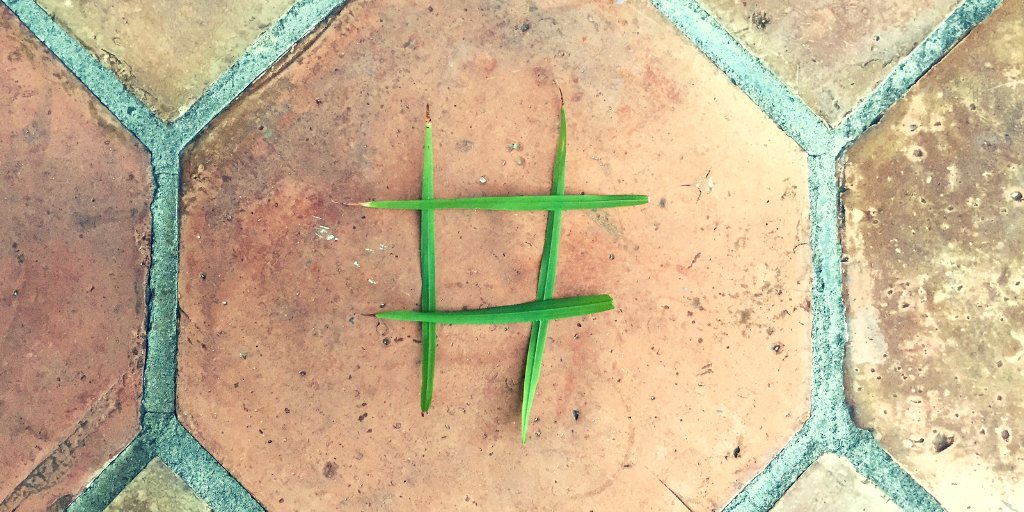POETRY of Hashtags for Interpretive Guides
In my talks at regional NAI workshops, hashtags always comes out as a high priority topic for Interpretive Guides beginning. I thought it would be fun to try to relate the National Association for Interpretation’s “POETRY” approach to communication to hashtag usage.
INTRO TO HASHTAGS
When you decide on a hashtag to use, you are essentially creating a feed or a stream that’s separate from the main feed.
In my talk, I used the example of lots of conversations going on at a party. The main feed of a platform (Facebook, Twitter, Instagram) is a general hum accumulating in real time where there’s no way you can really focus on anything. But if each group at the party splits up into hashtag identified conversations, then you get to pick which conversation/hashtag you want to join. The benefits?
- It’s easier to find something of interest to you.
- It’s easier to follow that conversation while it’s happening.You can even go back in time and see what people were talking about before you arrived.
- Better yet – you can go home early and check the hashtags the next morning to see what was said after you left!
- You can see what other hashtags people are using to mark the conversation and maybe find a conversation that’s even more interesting.
Remember, though. Your conversation is still at the big party and everybody in the room can see it, but they may not associate it with you or a topic or a conversation or your brand or your contest or your product or geographic area or any manner of categories unless you hashtag it.
I think hashtags are most effective on Instagram and Twitter. They are used other places, but I haven’t seen any real benefit. I monitor Twitter hashtags using Hootsuite.com. Instagram hashtags are easy to monitor within the app and through Instagram hashtag search function (the magnifying glass symbol). Most of my examples below focus on Instagram, but most can be applied to Twitter.
Hashtags are VERY useful to online fans of your resource, because it can make it easy for them to find and follow you.
Let’s see how hashtags can align with your interpretive style!

PURPOSEFUL Hashtags
- Don’t just randomly assign a hashtag. Have a purpose that relates to your resource and mission.
- Tip: Are you measuring something? What? (Contest entries, participants, recording an event, RTs, branding, etc.)
Example of a Purposeful Hashtag on Instagram: I like #FindYourPark because it inspires action and makes it personal. Plus, it’s short! I used #FindYourPark to mention King Gillette Ranch as the park I “choose” for the campaign – and @GoParks used their feed of that hashtag to invite me to join their contest. [@GoParks to me: Great story! Enter it in our contest at parks.org/fypenter, or reply #FYPyes to share it on FindYourPark.com without entering.”] That was their purpose . . . collect entries for their contest to measure their social interpretation efforts and gain new photos for their feed.
ORGANIZED Hashtags
- Pick something that’s short and easy to remember. For me, 12-14 characters is probably max.
- For an event, pick only ONE unifying hashtag. You don’t need two conversations on the same subject — unless you wanted to theme an extra feed with “bloopers” or some sort of scavenger hunt game where you’d want to judge based on the hashtag. You’ll get more participation and a richer feed when people don’t have to make a choice.
- Etiquette on Instagram is to put one or two hashtags in your original comment and then, if appropriate, immediately follow with other hashtags in the next comment.
- Tip: Always check the feed of the hashtag you choose to make sure there’s nothing unsavory already there. You would be surprised at what you will find.
Examples of Organized Hashtags: I wondered what hashtag I should use when we go on our summer tent camping trip up to the San Juan Islands from SoCal. There’s an existing hashtag for #pnw (Pacific Northwest) but it has 3.5 million photos in that feed. I’ll probably use it when we get up to Oregon and Washington as a way to join an existing conversation. But it’s a big conversation! #pnwoutdoors is a bit better fit and there are only 5,800 photos in that feed. When I look at the feed, my photos will fit right in. I have something in common with those who use this hashtag and they might follow me because we have something in common.

ENJOYABLE Hashtags
- It’s nice if it has some meaning built-in, so outsiders can join in or feel like they can be part of the conversation. They might even learn something new?
- Some hashtags are for humor and don’t really serve any purpose. You won’t be using these for work, but they can be personally entertaining. You know the ones — like #iwouldratherbecamping or #itsnotfunny.
Examples of Enjoyable Hashtags: If I want my Pacific Northwest trip to stand out for my readers and if I want to start my own conversation, I need to come up with something different than the pre-existing feeds. Kids are a great source for ideas! Mine came up with #Oranges2Orcas for our trip. It brings up an interesting visual and really conveys the change in landscapes that we’re going to experience. National Parks Trust runs a campaign every May for #KidstoParks Day and uses #BuddyBison to hashtag the journeys of their mascot stuffed animal to parklands across the country the rest of the year.
THEMATIC Hashtags
- Can you fit your theme into something as short as a hashtag? I bet you can! #FrogsAreGood #LeaveNoTrace
Example of a Thematic Hashtag: Patagonia has a campaign called #wornwear where people post photos of themselves and a story about their beloved Patagonia clothes calling it “The Stories We Wear: True stories of people and their Patagonia gear.” All you have to do is look at the photos in the feed to understand the theme. Now they even have a whole spin-off website.

RELEVANT Hashtags
- Are you listening or just broadcasting? To really master hashtags, you have to do your research. Listen to the conversations going on around you. Is there already a relevant hashtag for your conversation? Should you be joining it rather than making up your own?
- If people are using your hashtag outside your organization, then you know you are making a connection.
Example of a Relevant Hashtag: When I first started on Twitter, I found a group of like-minded individuals at #playoutdoors. What they said resonated with me and I joined their conversation. Since then, I’ve visited many of them in real life across the country, used them as sources for magazine articles on play, co-authored a Yellowstone travel guide with one, and partnered on website projects with another! In fact, I met up with two of them on that Pacific Northwest camping trip! All because of a hashtag.
YOU Hashtags
- Once you create a hashtag, you need to monitor it. Check who is jumping in and make sure you respond. Keep the conversation going. There’s nothing worse than jumping into a conversation and getting blank stares – which is how someone will feel if they get no response! You need to be the one to make your visitor feel comfortable and welcome. Even introduce them around to some of the other participants.
- Tip: Make sure you have a photo of yourself in your profile. Your invisible audience wants to see your face!
Example of a You Hashtag: What if you created a hashtag called #ifoundscat? I happen to know an Interpretive Specialist who LOVES scat and it would be fun for her to try and help her site visitors identify it. Then make sure you’re commenting on the photos that are submitted so that your readers will feel welcome and participate long into the future.
WANT TO LEARN MORE?
There are many, many blog posts on the use of hashtags. Mashable.com is a reputable source and many people consult SocialMediaExaminer.com (but you have to endure spammy pop-ups). The following Mashable post is from 2013 and still rings true, but in general you should be conscious of dates when searching for social media advice articles. Things change VERY quickly and what might have been good etiquette or effective in 2012 doesn’t fit anymore. I often add “2020” when I’m search for information on social media strategies.
- The Beginner’s Guide to the Hashtag (Mashable)
- My friend, Melissa (another from the #playoutdoors group who ended up going a different direction), runs a blog called BlogClarity.com and her social media advice is spot-on! For instance, she has a list of social media pet peeves and #2 on her list deals with hashtags.
Disclaimer: Don’t necessarily use my @planwritepost Instagram account as an example. I spend a lot of time experimenting to see what works and I’d hate for you to copy something that isn’t working!
